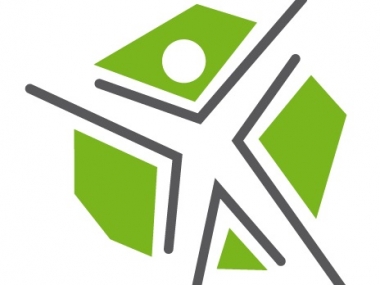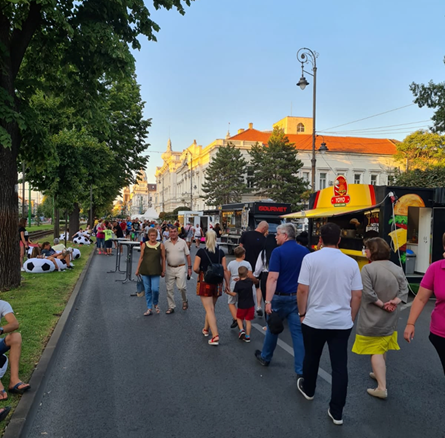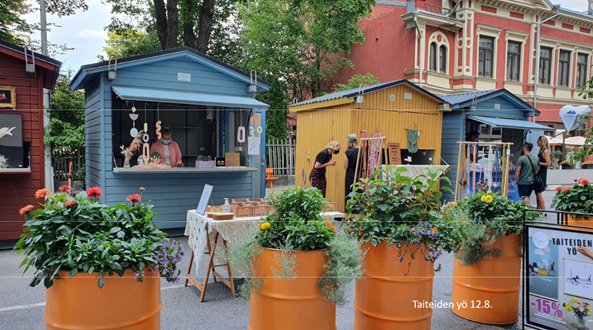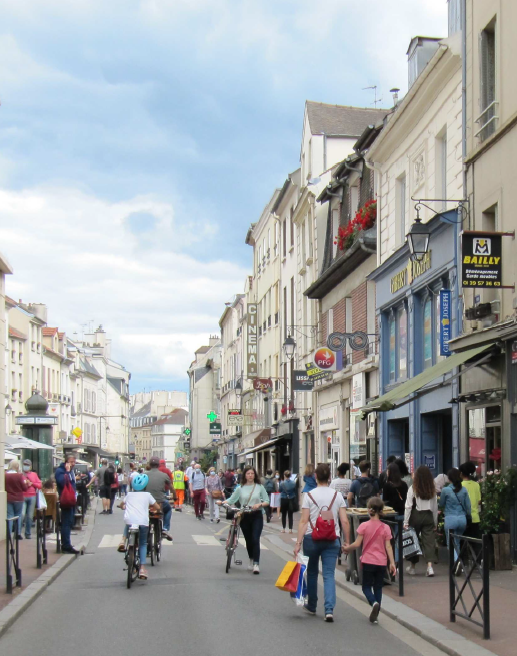About the value of public space and the big question on how to best make use of it
Edited on
21 January 2022Almost two years ago, a small group of cities decided to improve how they make use of their public space. They teamed up under the umbrella of URBACT calling themselves Space4People. And they were not alone: all over Europe and clearly also beyond, discussions and initiatives intensified on how to change municipalities and cities. On how to create liveable cities, healthy cities, attractive cities, green cities, playful cities. And how coming changes can help to meet one of the largest challenges we have ever met: climate change.

Well, it seems like a giant leap from a specific question as how to make use of public space to the enormous challenge presented by climate change. To what extent are these two issues interrelated? And is dealing with public space taking a role in this at all? A frank answer on this is yes, it does. Cities in the EU generate 23% of all transport related GHG emissions. And urban transport takes place in public space. But transport emissions do not pop-up by themselves. They are the result of travel needs and the modal choices we take. But it would be too easy to blame people to take ill-made modal choices. In the end, our cities and their public spaces have been designed to accommodate cars for decades. And we, people, make use of it as it is designed.
This is the point Space4People enters the scene. We take up the challenge of reviewing public space use and shifting it to people-centric use cases. It is already in the name, one could say. We deal with public space use in our cities working with one main use function: transport. We focus on walkability, quality of stay, a mix of functions, on public transport interchanges and parking management to come to public space designs and use cases meeting people’s actual needs and interest. But the topic of public space use tackling transport infrastructure provision and modal choice habits is all but easy. It deals with habits, privileges, different needs and different ideas. This is why our cities decided to use the frame of an URBACT network to work with public space. To exploit the wealth of knowledge and experience at hand for working with all kind of stakeholders. To apply an integrated planning process accommodating the needs and interests of people, of stakeholders.
Today, we as Space4People look back at more than 18 months of work for reshaping public space use. The methodology and tools of the URBACT programme proved to be of great value for both, planning public space use at local level and learning and exchanging on good practise and experiences at network level, specifically during the COVID19 pandemic. Our work plans needed drastic changes to allow both, local and network level work to continue, or even to begin. But with respect to Space4People in a certain way COVID19 was both, a curse and a blessing.
Do you remember spring 2020? The COVID19 spread out all over the world. Not even three months after the first flare-up, it had reached Europe - and paralyzed daily life: the sidewalks were rolled up everywhere. People drove a lot less in the first lockdowns. It was quiet in the cities, relaxed on the roads, of course the number of accidents went down in those days, and the air was fresh. In the midst of this terrible health crisis, there was a pleasant side effect: Many imagined to use the streets and squares after the pandemic without stress and traffic jams still. It seemed like an unplanned starting point because people could experience that public space isn´t reserved for cars but it could be used differently. People, media and politics became aware of the main subject of Space4People.
But on the other hand, COVID19 had deep impacts in the daily work. The start of our URBACT Local Group (ULG) work was a rather bumpy one. Our cities as well as the city societies perceived meetings and joint group work with a rather reserved view at the late time of the first heavy COVID19 restrictions and its lockdowns. Albeit most of our cities established first ULGs already during Phase 1, digital work structures coping with the new reality of COVID19 were no widespread and everyday practises yet. This is where network level work came in as a supportive momentum for local work. Thanks to the advice, support and training by the URBACT programme, Space4People experimented with digital meeting formats using solutions like Zoom and Miro during the first months of its work cumulating to first experiences for digital work within the first network meeting. Thanks to the additional advice and work with our digital expert Liat Rogel, these new capacities got transferred to the local work level and allowed an adaptation of tasks.
ULG work and meetings themselves started in digital formats using Zoom or similar online meeting software. Work elements relied on usage of beforehand surveys but as well digital white boards and cloud-based tools. The work process was split into frequent small group management meetings and larger involvement formats following the logic of the integrated planning process. Still, extending the ULGs to involve more stakeholders and different population groups remained problematic until the end of 2020. At this point, Space4People cities started to invest more time and resources in planning their small-scale activities.
This new feature of the Action Planning Network strand of the URBACT Programme proved to be a trigger and driver for local work. Discussing locations, formats and nature of these pilots as tangible activities in our cities increased interest and involvement of stakeholders in our work. We started with local communication activities: originally planned as events in relevant public spaces, our cities adapted and used surveys, exhibitions, posters in public space, small meeting settings with specific stakeholder groups like the retail community or lectures to increase awareness on their work and to the planning of the small-scale activities. Implementing the small-scale activities was a further push to activate people. Most Space4People cities experimented with a change to road use in specific locations:
Like the City of Arad (RO) that experimented with traffic closures on the main road crossing the heart of the city. Parts of the boulevard got closed to motorised traffic end of August combined with events and gastronomy offers to demonstrate the different use case to people. The Arad ULG drove a two-step participation exercise using the opportunity of having many people at hand: first, they collected people’s ideas and needs for locations and timing of pedestrianisation projects in the city centre. The surprising result was that most input requested to work with the main boulevard directly including proposals to fully pedestrianise sections of the road. Second, they invited the by-passers during the road closure to tell details on what installations, equipment, outdoor furniture and events they would like to see in new pedestrian sections. On-street food sales, shading, seating, greeneries and street arts were the most popular options to take forward to the detailed action planning of the Arad ULG.

Like the City of Turku (FI) who installed a “summer street” in the city centre cutting out a section of the Kristiinankatu from the traffic grid and dedicating space to lingering in public space, to outdoor gastronomy, events and a stage open for anybody to use. Turku closed the road section the entire July and August dividing the section into a public seating and event area and a gastronomy area. The Turku ULG put life to the summer street by involving festivals and events in the city to it, by putting markets and stalls into it, by gamification elements for children and by the “event carpet” – the stage that everyone could rent for a symbolic price to perform music and other art performances. Turku employed extensive monitoring work to the effects of the summer street. This included traffic counts before and during the summer street, stationary people mapping to see how the summer street is used as well as interviews and survey with its users, with residents, retailers and gastronomy. Results confirmed a good use of the experiment: people populated the summer street, especially in the part dedicated to seating and events.

Like the City of Saint-Germain-en-Laye (FR), who even took advantage of the emerging COVID19 pandemic and its hard lockdowns already in spring 2020. Saint-Germain-en-Laye used this momentum to experiment with changes in public space design and use: they tested the extension of the pedestrian zone in the city centre and combined this pilot with surveys to the centre’s retailers and gastronomy as well as its residents and visitors. Surveys covered the perception of the pedestrian space extension and asked for opinion and use intention to further services focusing on deliveries, parking and access. The activities included testing outdoor furniture and installations marking public space use such outdoor seating options. As a first result, Saint-Germain-en-Laye converted parts of the central Rue de Poissy to a pedestrian street. Another results was that retail and gastronomy outside the experiment’s perimeter asked for signposting to direct pedestrians also to their location.

The results of the small-scale activities differed a lot from city to city but produced valuable insights and effects fitting to the needs of each city. The range of results was wide and included amongst others the successful activation of residents and stakeholders to the need for changing public space use, as achieved in the Vabaduse Street of our Estonian partner town Valga, the demonstration of more sustainable travel choices as performed by the public transport service tests in Lithuanian Panevėžys or an initial change in perception of people, business and political decision makers as achieved in Turku. Piloting activities were not uncontested all the time, though. Performing communication events that accompanied the small-scale activities, like on-street stalls during the European Mobility Week in Serres (EL) and discussing with public space users directly on site proved necessary and useful in this. Our cities gained valuable knowledge and experiences thanks to the small-scale activities. And they have a strong intention to keep using them in their future efforts, no matter if inside Space4People or for other opportunities.
Today, we as Space4People are focusing on the further elaboration of our Integrated Action Plans (IAP) alongside the path of our ULG work. Right now, most of our cities are focusing on detailing the actions that got identified for the IAP. But we still need to cope with a bunch of challenges to finally deliver well-designed and implementable plans by summer 2022:
Barriers to ULG work itself remained valid to some extent centring around the availability of our city society stakeholders and the increasing tiredness to digital engagement formats.
Maintaining involvement of stakeholders and the public and at the same time start the transition of the co-creation process to a co-delivery process in preparation of the IAP implementation.
Setting up sound and robust financing structures fitting to the different resource needs and budget sources to allow actions being put in practise.
Technical input needs to see a shift of focus from pedestrianisation and how new use cases for public space can look like towards parking management to work at the “supply-side” new public space designs.
One of the main steps at hand right now aside the completion of action details is a permanent integration check of our plans. And to exchange on this to take on good ideas: like the municipality of Guia de Isora who started territorial integration by involving the business associations of neighbouring municipalities. Or like their structure of the ULG work in effective subgroups e.g. the political one to enlarge horizontal involvement. Like Saint-Germain-en-Laye exploiting vertical cooperation structures by different public authority levels. Like Valga combining ULG meetings with public lectures and discussion forums to foster a further enlargement of involved citizens and stakeholders. Like Bielefeld using the momentum to work with awareness, campaigning, testing and physical changes to mix hard and soft approaches. Some aspects of an integration check are easier though thanks to our political challenge: one of the earliest lessons learnt in Space4People was that public space development involves many more aspects and sectors than “just” transport or place management. Still, we well recognised in our latest network meeting that further work is needed to create truly integrated plans: To enlarge the involvement of city society stakeholders for a wider consensus on the IAP. To align the IAP to higher-level governance objectives, not the least to create favourable conditions for applying to funding.
In the coming month, our focus will move to the transition of planning for actions to managing their implementation and funding. We are counting on the support of the URBACT Programme as by the coming e-university in this. And we are extending our perspective beyond the world of Space4People thanks to the collaboration with our sister networks RiConnect and Thriving Streets. Together, we form the Walk’n’Roll group: visit us on LinkedIn by searching for Walk’n’Roll to learn on our activities to change our cities’ road and streets to people-friendly spaces!
Changing how public space remains yet a demanding challenge. We still need to deal with decade-old use patterns fixed in people’s and stakeholders’ mindsets. We still need to tackle the strong notion that parking is a common good that needs to be available in our public spaces, even for free. In each of our cities, we communicate, explain and promote that this can be changed though. That our cities can be more attractive, can be spaces to accommodate people and their needs and interests. We showcase how this can look like thanks to piloting activities. And bit by bit gain support and understanding for our idea of more liveable public spaces. Greener spaces. Healthier spaces. Spaces to meet, to play, to socialise. And by the changes we push for, we deliver our small contribution to the large challenges of today, like an inclusive society, a resilient one, and as well to mitigate climate change.
We look forward to tell you more on our work and our achievements in the coming month!
Submitted by Claus Kollinger on
